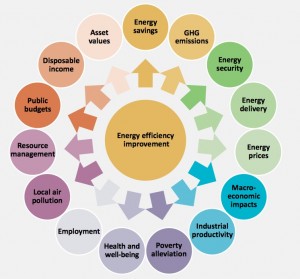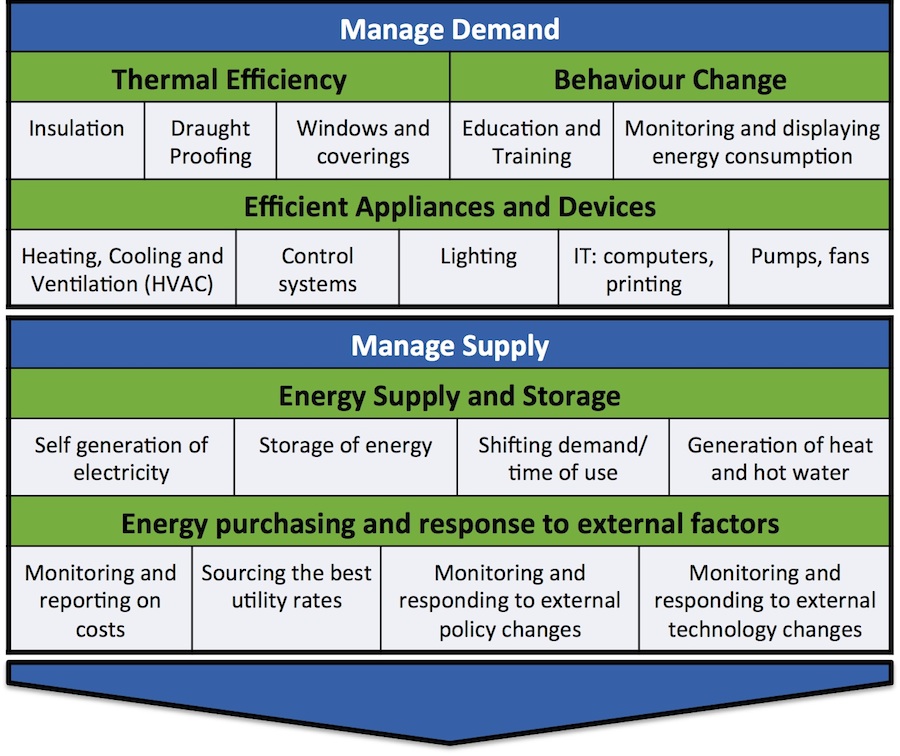For many facilities – aged care establishments, schools, housing developments, offices, and homes – a solar PV system is a great opportunity to help reduce the cost of electricity from the grid. But there are plenty of solar PV system salespeople out there who will happily sell you a system which really does not match your needs well at all … ends up costing your far more than you expect and does not pay itself back within a reasonable time. There are even PV salespeople who will effectively lie to you about what a system will produce. See the “rules of thumb” for system output below.
So how do you ensure that you get the right sized system, at a reasonable price, and that the system you buy will pay itself within a reasonable number of years?
- You have the system designed in conjunction with an energy efficiency review of your facility – so that the most cost effective means of reducing energy consumption are chosen – one of which may be PV panels.
- You have the system designed to match the daytime consumption of your facility – so that export to the grid is minimised or prevented entirely.
- You have the system designed so that it’s ready to be upgraded once the cost of energy storage reduces to financially attractive levels.
That’s where Efficient Initiatives comes in. We know PV systems. We know energy efficient lighting, heating, ventilation, air conditioning. We know building thermal performance. We know where to get the best rates for power and gas. We work with you to get the entire package of energy efficiency and generation measures right – now and into the future.
What are some of the characteristics of the “right design” of a solar PV system?
- Avoid shading – even a little bit of shading during the best sun hours of the day, particularly 10am-2pm, will have a significant impact.
- Select PV panels and inverters from suppliers who have a good chance of still being around when you need to call on that warranty.
- Match the system output over the year with the expected consumption at your facility … after energy efficiency measures have been put into place
- Face your solar panels north, but also potentially east and west … in the right combination to match your consumption profile and your roof profile.
- Ensure that cables are sized correctly. Watch out for voltage drop or, in the case of micro inverters, voltage rise.
- Checking that your roof is structurally capable of supporting the PV system under expected wind loads. Designing the connection system to prevent leaks.
- Set up an ongoing monitoring program – so that when something does go wrong, you don’t lose half a year’s production before somebody notices.
PV system output – how much energy will my system produce?
In the PV industry, most people are honourable and honest. But there are a number of salespeople who will outright lie to you about what your system will produce. The following rules of thumb can be used – or else jump on to the PV Watts calculator to estimate your system production yourself. If you do use the PV Watts calculator, it asks for a “derate factor”. This should be left at the recommended value in general, or at most increased to around 0.8 or 0.82.
Bottom line? A PV system will not produce significantly more than these figures. It will produce less if it’s not well sited or if there’s any shading.
Rules of thumb for PV system generation in Australia. Apologies for being Victoria-centric but it’s where most of our customers are based:
|
|
Output per kW capacity |
| Location |
Panel orientation |
Average Annual output |
Average daily output |
| Melbourne and southern Victoria |
Facing north at 25-35˚ to the horizontal |
1300 kWh |
3.6kWh |
| Melbourne and southern Victoria |
Flat on the roof (no! don’t do this! Your panels will get dirty and stay dirty) |
1150kWh (assuming you clean them several times per year) |
3.2kWh |
| Melbourne and southern Victoria |
Facing east or west at 25-35˚ to the horizontal |
1050kWh |
2.9kWh |
| Mildura, Canberra, Adelaide |
Facing north at 20-30˚ to the horizontal |
1500kWh |
4.2-4.3kWh |
| Hobart-Tasmania |
Facing north at 30-35˚ to the horizontal |
1280 kWh |
3.5kWh |
| Sydney |
Facing north at 20-30˚ to the horizontal |
1400kWh |
3.9kWh |
| Brisbane |
Facing north at 20-30˚ to the horizontal |
1500kWh |
4.2kWh |
| Perth |
Facing north at 20-30˚ to the horizontal |
1580kWh |
4.4kWh |
With the above table, multiply your system’s capacity in kW by the output per kW capacity to get your total kWh production. You can then multiply that by the rate at which you buy power to get an estimate of what you might save – assuming you use all of this electricity within your facility and don’t export any to the grid.
For example: a new, clean, unshaded 30kW system in Melbourne orientated to the north should produce on average 39,000kWh per year.
One point from the table above is the question of facing east, west or north. An approximately north (within say 20˚ of north) orientation will maximise energy production across the year. But this may not be the best outcome for you: it might be better to face some panels to the east if you have a morning peak of consumption, and to face some panels to the west if you have an afternoon peak of consumption. The reduction in output – of around 20% by facing east or west compared with north – may be worth while to maximise the “self consumption” from your system.
The bottom line
Does this sound a little confusing? While PV systems are inherently straightforward, there are lots of things which can be designed and installed well, or designed and installed poorly. Efficient Initiatives will partner with you to ensure you get the right system, at the right cost to match your energy needs.


